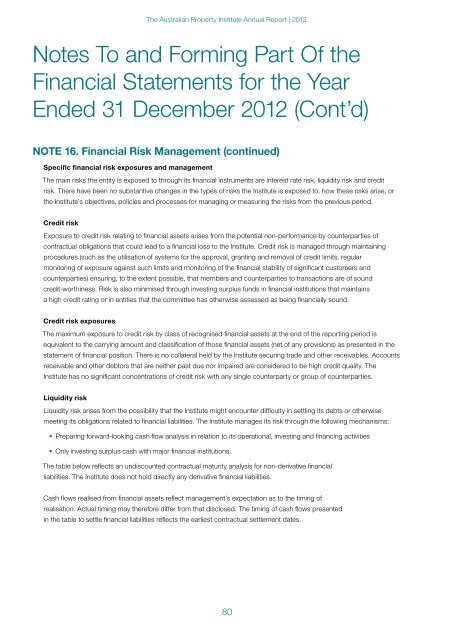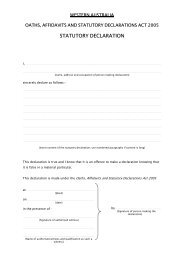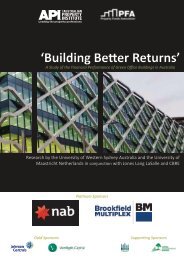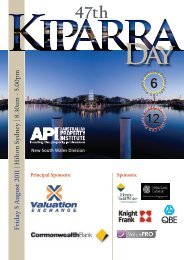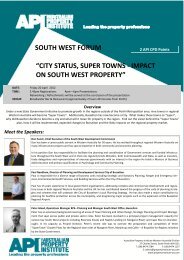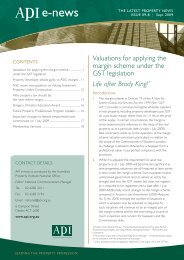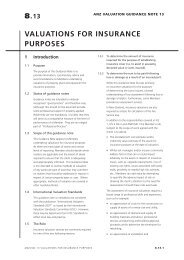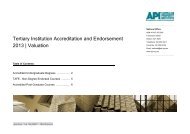Annual Report 2012 - The Australian Property Institute
Annual Report 2012 - The Australian Property Institute
Annual Report 2012 - The Australian Property Institute
You also want an ePaper? Increase the reach of your titles
YUMPU automatically turns print PDFs into web optimized ePapers that Google loves.
<strong>The</strong> <strong>Australian</strong> <strong>Property</strong> <strong>Institute</strong> <strong>Annual</strong> <strong>Report</strong> | <strong>2012</strong>Notes To and Forming Part Of theFinancial Statements for the YearEnded 31 December <strong>2012</strong> (Cont’d)NOTE 16. Financial Risk Management (continued)Specific financial risk exposures and management<strong>The</strong> main risks the entity is exposed to through its financial instruments are interest rate risk, liquidity risk and creditrisk. <strong>The</strong>re have been no substantive changes in the types of risks the <strong>Institute</strong> is exposed to, how these risks arise, orthe <strong>Institute</strong>’s objectives, policies and processes for managing or measuring the risks from the previous period.Credit riskExposure to credit risk relating to financial assets arises from the potential non-performance by counterparties ofcontractual obligations that could lead to a financial loss to the <strong>Institute</strong>. Credit risk is managed through maintainingprocedures (such as the utilisation of systems for the approval, granting and removal of credit limits, regularmonitoring of exposure against such limits and monitoring of the financial stability of significant customers andcounterparties) ensuring, to the extent possible, that members and counterparties to transactions are of soundcredit-worthiness. Risk is also minimised through investing surplus funds in financial institutions that maintainsa high credit rating or in entities that the committee has otherwise assessed as being financially sound.Credit risk exposures<strong>The</strong> maximum exposure to credit risk by class of recognised financial assets at the end of the reporting period isequivalent to the carrying amount and classification of those financial assets (net of any provisions) as presented in thestatement of financial position. <strong>The</strong>re is no collateral held by the <strong>Institute</strong> securing trade and other receivables. Accountsreceivable and other debtors that are neither past due nor impaired are considered to be high credit quality. <strong>The</strong><strong>Institute</strong> has no significant concentrations of credit risk with any single counterparty or group of counterparties.Liquidity riskLiquidity risk arises from the possibility that the <strong>Institute</strong> might encounter difficulty in settling its debts or otherwisemeeting its obligations related to financial liabilities. <strong>The</strong> <strong>Institute</strong> manages its risk through the following mechanisms:• Preparing forward-looking cash flow analysis in relation to its operational, investing and financing activities• Only investing surplus cash with major financial institutions.<strong>The</strong> table below reflects an undiscounted contractual maturity analysis for non-derivative financialliabilities. <strong>The</strong> <strong>Institute</strong> does not hold directly any derivative financial liabilities.Cash flows realised from financial assets reflect management’s expectation as to the timing ofrealisation. Actual timing may therefore differ from that disclosed. <strong>The</strong> timing of cash flows presentedin the table to settle financial liabilities reflects the earliest contractual settlement dates.80


